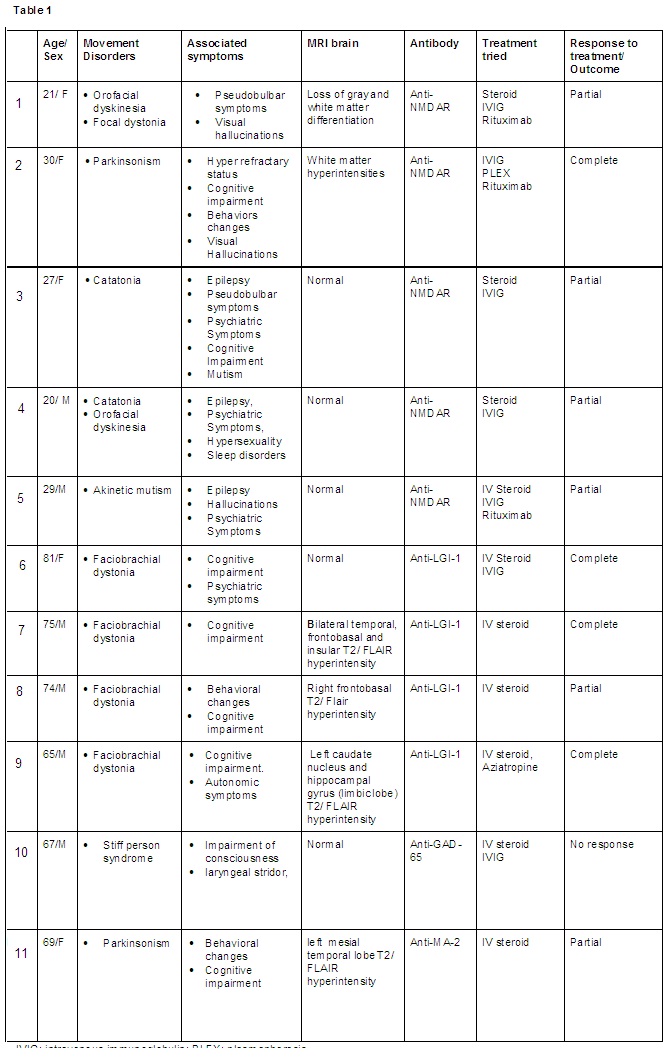Category: Other
Objective: Describe abnormal movements associated with autoimmune encephalopathies (AIE)
Background: Movement disorders are a hallmark feature of autoimmune encephalitis (AIE), playing a pivotal role in its diagnosis and management (1). Dyskinesias, mainly affecting the mouth and limbs, are characteristic of encephalitis associated with NMDAR antibodies. Faciobrachial dystonic seizures (FBDS) are consistently linked to LGI1 antibodies. Furthermore, parkinsonism is associated with Ma2-antibodies, while stiff person spectrum disorders are linked to GAD antibodies. Although tremor isn’t typically seen as an isolate symptom in antibody-mediated disorders, it can be part of a broader encephalopathic presentation related to LGI1/CASPR2 and NMDAR (2).
Method: We presented a series of 11 cases with movement disorders associated with AIE between 2017 and 2023. We included cases that satisfied criteria for definite AIE (3). We collected demographic data, clinical features, treatments and outcomes (Table 1).
Results: NMDAR was found in 5 patients, LGI-1 in 4 patients, and 2 patients with GAD-65 and Anti-MA 2. Mean age in NMDAR patients was 25.4 years [20-30]. In patients with other antibodies was 71.8 y.o [65-81]. All patients with LGI-1 presented Faciobrachial dystonia. NMDAR patients presented a predominant hypokinetic movement disorder and in the 2 younger patients we observed Orofacial dyskinesia.
All patients showed concomitant cognitive and/or psychiatric symptoms, and 4/5
of NMDA patients manifested epilepsy.
In 8 patients was necessary a second or third line of treatment. Only 4 patients exhibited a complete remission.
Conclusion: Movement disorders are frequently seen in AIE and could serve as valuable clues for their early diagnosis. They could be present in a wide range of ages, nevertheless, anti-NMDAR antibodies usually can be seen in younger adults.
Although there are typical movement disorders, as faciobrachial dystonia in LGI-1 AIE, in certain cases a single antibody can be associated with various movement disorders, and conversely, a single movement disorder may be found from different antibodies.
In AIE, movement disorders are not the only manifestation. They are often associated with psychiatric and cognitive impairment, behavioral changes, and epilepsy. Early suspicion for diagnosis allows us to initiate appropriate immunomodulatory treatment, as soon as possible.
Table 1
References: 1- Chouksey A, Pandey S. Autoimmune Movement Disorders: A Video-Based Case Series of 11 Patients. Eur Neurol. 2021;84(2):124-128. doi: 10.1159/000514106. Epub 2021 Mar 22. PMID: 33752203.
2- Balint B, Vincent A, Meinck HM, Irani SR, Bhatia KP. Movement disorders with neuronal antibodies: syndromic approach, genetic parallels and pathophysiology. Brain. 2018 Jan 1;141(1):13-36. doi: 10.1093/brain/awx189. PMID: 29053777; PMCID: PMC5888977.
3- Graus F, Titulaer MJ, Balu R, Benseler S, Bien CG, Cellucci T, Cortese I, Dale RC, Gelfand JM, Geschwind M, Glaser CA, Honnorat J, Höftberger R, Iizuka T, Irani SR, Lancaster E, Leypoldt F, Prüss H, Rae-Grant A, Reindl M, Rosenfeld MR, Rostásy K, Saiz A, Venkatesan A, Vincent A, Wandinger KP, Waters P, Dalmau J. A clinical approach to diagnosis of autoimmune encephalitis. Lancet Neurol. 2016 Apr;15(4):391-404. doi: 10.1016/S1474-4422(15)00401-9. Epub 2016 Feb 20. PMID: 26906964; PMCID: PMC5066574.
4- Bernardo F, Rebordão L, Rêgo A, Machado S, Passos J, Costa C, Cruz S, Pinto AN, Santos M. Stiff person spectrum disorders: An illustrative case series of their phenotypic and antibody diversity. J Neuroimmunol. 2020 Apr 15;341:577192. doi: 10.1016/j.jneuroim.2020.577192. Epub 2020 Feb 13. PMID: 32087460.
5- Dash D, Pandey S. Movement disorders associated with neuronal antibodies. Acta Neurol Scand. 2019 Feb; 139(2): 106–17.
6- Honnorat J, Joubert B. Movement disorders in autoimmune encephalitis and paraneoplastic neurological syndromes. Rev Neurol (Paris). 2018 Nov;174(9):597-607. doi: 10.1016/j.neurol.2018.07.006. Epub 2018 Sep 7. PMID: 30201423.
7- Rodríguez Cruz PM, Pérez Sánchez et al. Alternating faciobrachial dystonic seizures in LGI1-antibody limbic encephalitis. Pract Neurol. 2016 Oct;16(5):387-8. doi: 10.1136/practneurol-2016-001375. Epub 2016 Mar 16.
To cite this abstract in AMA style:
G. Costa, C. Del Prado, A. Marin, I. Apaza, M. Bendersky, C. Simison, P. Hernandez, F. Echeverria, T. Arakaki, S. Rodriguez Quiroga, N. Garretto. Movement Disorders in Autoimmune Encephalitis: A case series of 11 cases. [abstract]. Mov Disord. 2024; 39 (suppl 1). https://www.mdsabstracts.org/abstract/movement-disorders-in-autoimmune-encephalitis-a-case-series-of-11-cases/. Accessed April 18, 2025.« Back to 2024 International Congress
MDS Abstracts - https://www.mdsabstracts.org/abstract/movement-disorders-in-autoimmune-encephalitis-a-case-series-of-11-cases/

